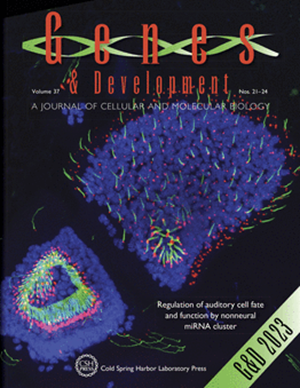A noncanonical Pol III-dependent, Microprocessor-independent biogenesis pathway generates a germline-enriched miRNA family
IF 7.7
1区 生物学
Q1 CELL BIOLOGY
引用次数: 0
Abstract
MicroRNAs (miRNAs) are short RNAs that post-transcriptionally regulate gene expression. In canonical miRNA biogenesis, primary miRNAs are transcribed from intergenic loci or intronic regions by RNA polymerase II and sequentially cleaved by the Microprocessor complex and Dicer, and the resulting mature miRNAs are loaded into Argonaute to repress target mRNAs. A minority of miRNAs are generated via noncanonical biogenesis pathways that bypass the Microprocessor complex and/or Dicer. Here, we describe a new Pol III-dependent, Microprocessor-independent, and Dicer-dependent biogenesis pathway exemplified by the mir-1829 family in Caenorhabditis elegans. Although the mir-1829 family loci reside in intronic regions of protein-coding genes, we show that the miRNAs are derived from independent Pol III transcripts. Unlike other Pol III-dependent miRNAs, the mir-1829 family small RNAs are the dominant species derived from their loci rather than fragments of a larger functional noncoding RNA. These germline-enriched miRNAs are loaded in multiple miRNA Argonautes, including the recently characterized germline Argonaute ALG-5, which we demonstrated is repressive when tethered to a reporter transcript. We extend these findings, identifying additional Pol III transcribed and noncanonical small RNAs in C. elegans and human data sets, including human miR-4521. These young, noncanonical miRNAs may represent an early snapshot in the evolution of de novo miRNA genes.一个非规范的依赖于Pol iii,不依赖于微处理器的生物发生途径产生了一个种系富集的miRNA家族
MicroRNAs (miRNAs)是一种转录后调控基因表达的短rna。在典型的miRNA生物发生中,初级miRNA由RNA聚合酶II从基因间位点或内含子区转录,然后由微处理器复合体和Dicer依次切割,产生的成熟miRNA被装载到Argonaute中抑制目标mrna。少数mirna是通过绕过微处理器复合物和/或Dicer的非规范生物发生途径产生的。在这里,我们描述了一个新的Pol iii依赖性,微处理器依赖性和dicer依赖性的生物发生途径,以秀丽隐杆线虫中的mir-1829家族为例。尽管mir-1829家族位点位于蛋白质编码基因的内含子区域,但我们发现mirna来源于独立的Pol III转录本。与其他依赖Pol iii的mirna不同,mir-1829家族小RNA是来自其基因座而不是更大的功能性非编码RNA片段的优势种。这些生殖系富集的miRNA装载在多种miRNA Argonaute中,包括最近表征的生殖系Argonaute ALG-5,我们证明当连接到报告转录本时,它是抑制性的。我们扩展了这些发现,在秀丽隐杆线虫和人类数据集中鉴定了额外的Pol III转录和非规范小rna,包括人类miR-4521。这些年轻的、非规范的miRNA可能代表了新生miRNA基因进化的早期快照。
本文章由计算机程序翻译,如有差异,请以英文原文为准。
求助全文
约1分钟内获得全文
求助全文
来源期刊

Genes & development
生物-发育生物学
CiteScore
17.50
自引率
1.90%
发文量
71
审稿时长
3-6 weeks
期刊介绍:
Genes & Development is a research journal published in association with The Genetics Society. It publishes high-quality research papers in the areas of molecular biology, molecular genetics, and related fields. The journal features various research formats including Research papers, short Research Communications, and Resource/Methodology papers.
Genes & Development has gained recognition and is considered as one of the Top Five Research Journals in the field of Molecular Biology and Genetics. It has an impressive Impact Factor of 12.89. The journal is ranked #2 among Developmental Biology research journals, #5 in Genetics and Heredity, and is among the Top 20 in Cell Biology (according to ISI Journal Citation Reports®, 2021).
 求助内容:
求助内容: 应助结果提醒方式:
应助结果提醒方式:


